Spaghetti Bolognese is a classic Italian dish that has gained immense popularity worldwide. It is a delicious and hearty meal that is perfect for any occasion, be it a quick weekday dinner or a special family gathering.
The dish features spaghetti noodles with a rich and flavorful meat sauce called Bolognese sauce. The sauce is usually made with ground beef, tomatoes, onions, and a variety of herbs and spices, giving it a robust and savoury taste.
Spaghetti Bolognese is a beloved dish that is enjoyed by people of all ages and backgrounds, making it a staple in many households. In this article, we will explore the history, ingredients, variations of this classic dish and tips on how to perfect it.
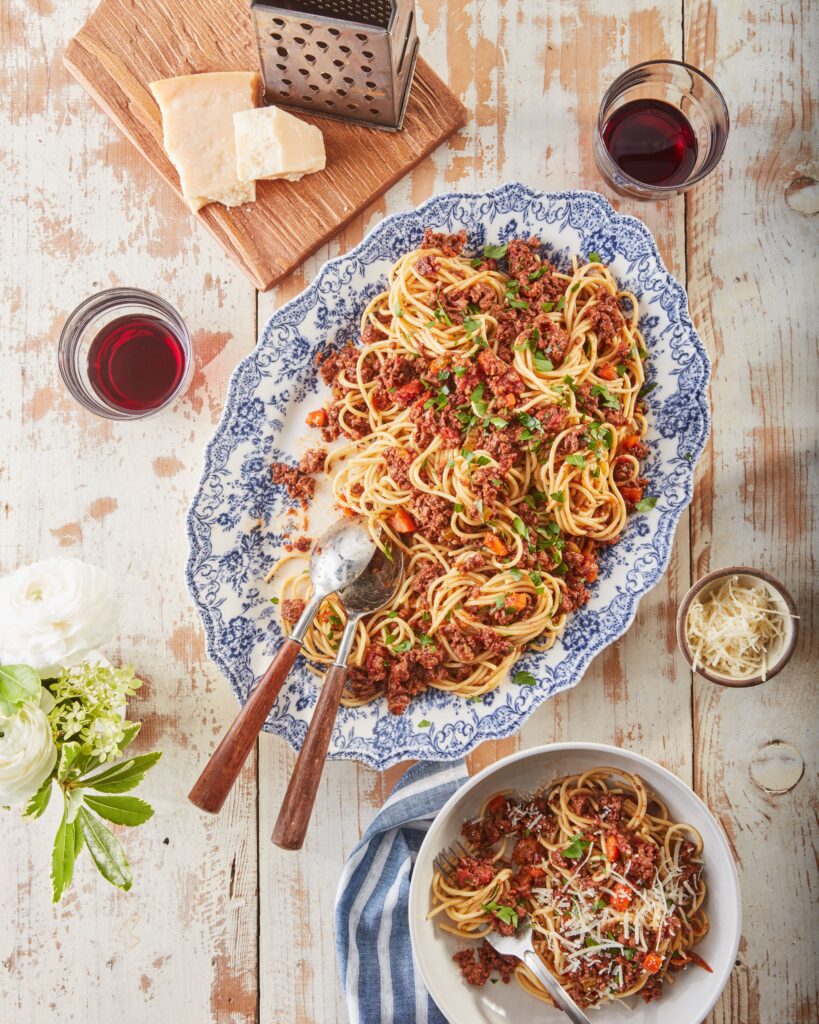
MORE IN THIS SERIES:
- How to make pepper soup
- Green Tea Shot Recipe
- 15+ Best Mexican Drinks to Pair with your Favourite Dishes
Ingredients for Spaghetti Bolognese
- 1 tbsp olive oil
- 4 rashers smoked streaky bacon
- 2 medium onions,
- 2 carrots, trimmed
- 2 celery sticks,
- 2 garlic cloves
- 2-3 sprigs of rosemary leaves
- 500g beef mince
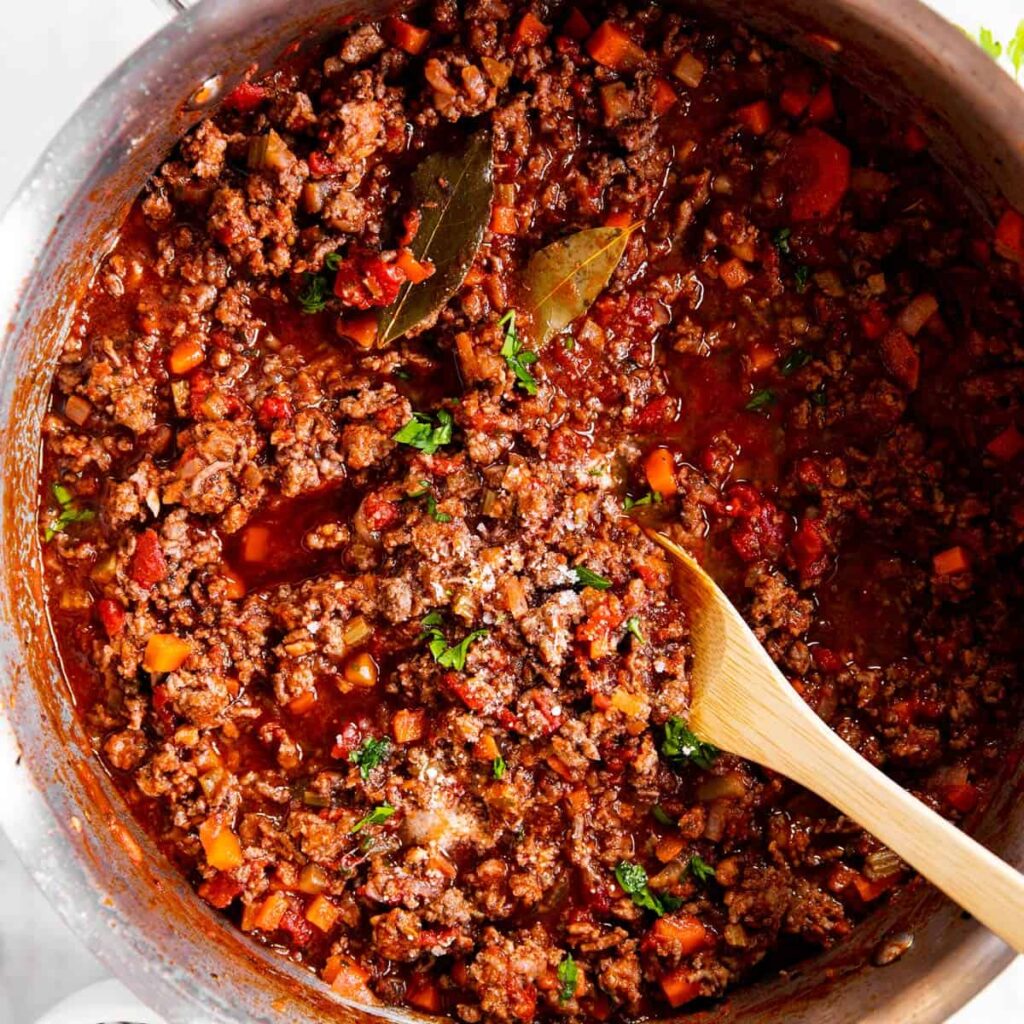
Bolognese Sauce
- 2 x 400g tins plum tomatoes
- A small pack of basil leaves picked, ¾ finely chopped, and the rest left whole for garnish
- 1 tsp dried oregano
- 2 fresh bay leaves
- 2 tbsp tomato purée
- 1 beef stock cube
- 1 red chilli deseeded
- 125ml red wine
- 6 cherry tomatoes sliced in half
For Season and Serve
- 75g parmesan grated, plus extra to serve
- 400g spaghetti
- crusty bread
Importance of the Basic Ingredients for Spaghetti Bolognese
The ingredients for Spaghetti Bolognese can vary slightly depending on personal preference and the recipe used, but the basic components include
1. Ground beef
This is the primary ingredient for the Bolognese sauce, and it is usually made with lean ground beef. However, some recipes use ground pork, veal, or a combination of different meats.
2. Tomatoes
Tomatoes are a crucial ingredient in the Bolognese sauce, and they can be used in different forms, such as canned tomatoes, tomato paste, or fresh tomatoes.
3. Onions and garlic
These aromatics add depth of flavour to the sauce and are usually sautéed with ground beef.
Carrots and celery
These vegetables are commonly used to add sweetness and balance the acidity of the tomatoes. They are usually finely chopped and sautéed with onions and garlic.
Red wine
This is an optional ingredient but is commonly used to enhance the flavour of the Bolognese sauce.
Herbs and spices
Common herbs and spices used in the Bolognese sauce include bay leaves, oregano, thyme, and basil. Salt and pepper are also used to season the sauce.
Spaghetti noodles
Spaghetti noodles are used to serve the Bolognese sauce and can be cooked according to personal preference.
Parmesan cheese
Parmesan cheese is commonly used to garnish Spaghetti Bolognese and add a salty and nutty flavour.
Related: How to make Sushi Burrito: Homemade Sushi Recipe
How to cook Spaghetti Bolognese.
- Put a large saucepan on medium heat and add 1 tbsp olive oil.
- Add 4 finely chopped bacon rashers and fry for 10 mins until golden and crisp.
- Reduce the heat and add the 2 onions, 2 carrots, 2 celery sticks, 2 garlic cloves, and the leaves from 2-3 sprigs of rosemary, all finely chopped, then fry for 10 mins. Stir the veg often until it softens.
- Increase the heat to medium-high, add 500g beef mince, and cook, stirring for 3-4 mins until the meat is browned all over.
- Add 2 tins plum tomatoes, the finely chopped leaves from ¾ small pack basil, 1 tsp dried oregano, 2 bay leaves, 2 tbsp tomato purée, 1 beef stock cube, 1 deseeded and finely chopped red chilli (if using), 125ml red wine and 6 halved cherry tomatoes. Stir with a wooden spoon, breaking up the plum tomatoes.
- Bring to a boil, reduce to a gentle simmer, and cover with a lid. Cook for 1 hr 15 mins stirring occasionally, until you have a rich, thick sauce.
- Add the 75g grated parmesan, check the seasoning, and stir.
- When the bolognese is nearly finished, cook 400g of spaghetti following the pack instructions.
- Drain the spaghetti and stir it into the bolognese sauce or serve it on top. Serve with more grated parmesan, the remaining basil leaves, and crusty bread, if you like.
Related: How to cook fried rice one step at a time
Spaghetti Bolognese Variations.
There are many variations of spaghetti bolognese that can be made to suit different tastes and dietary requirements.
Here are a few examples:
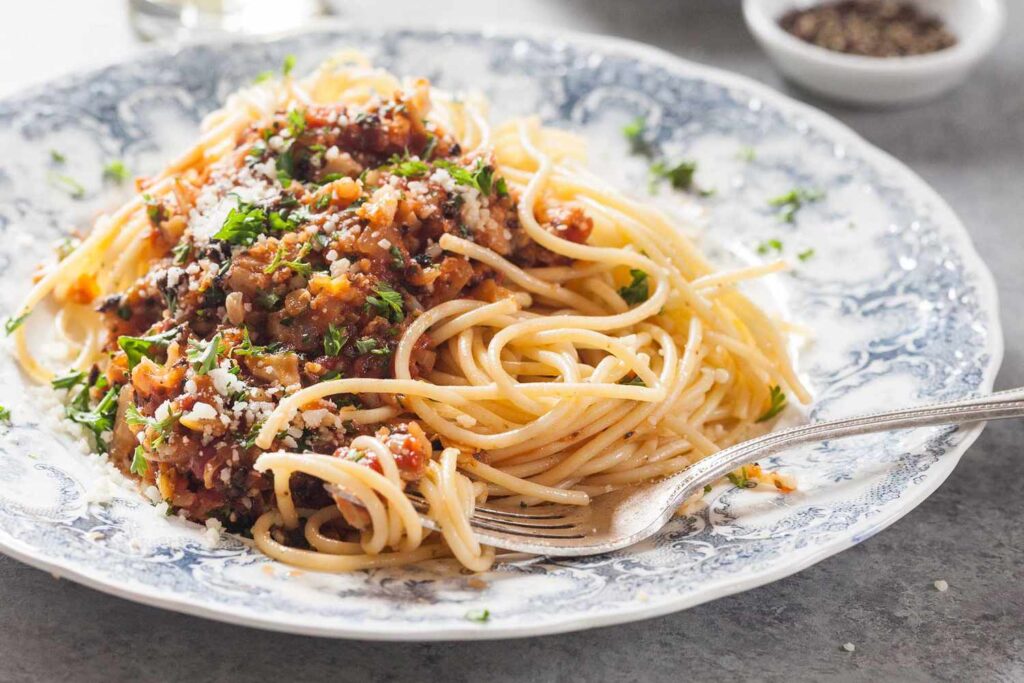
Vegetarian Spaghetti Bolognese
Instead of using ground beef, substitute with plant-based protein such as tofu or tempeh. You can also add more vegetables like zucchini, carrots, and mushrooms.
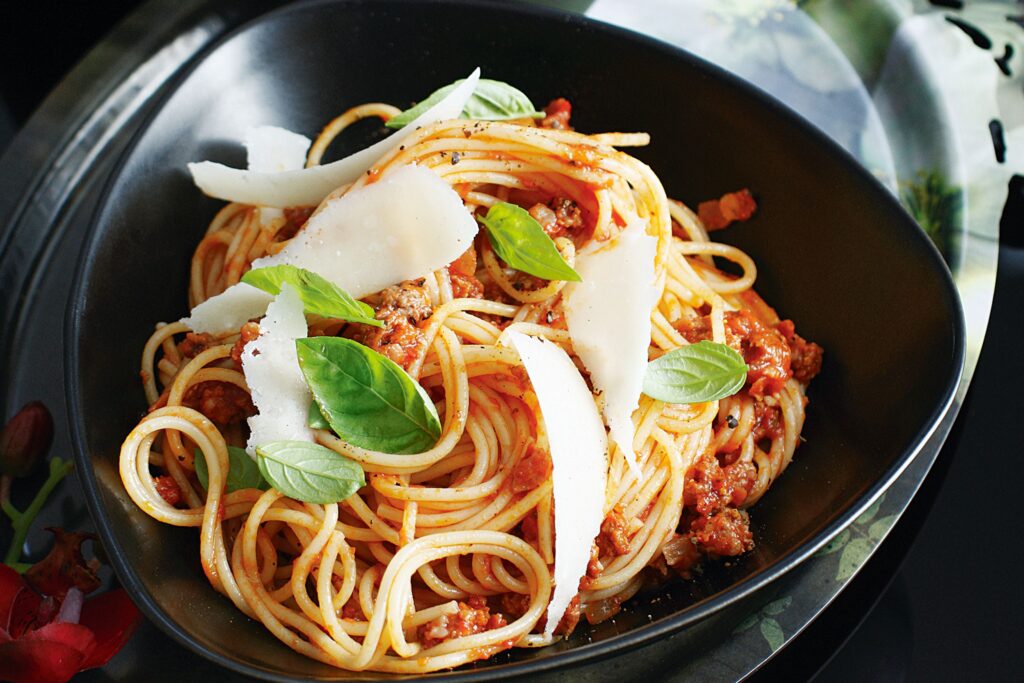
Spicy Spaghetti Bolognese
Add chilli flakes, paprika, or cayenne pepper to the sauce to give it a kick of heat.
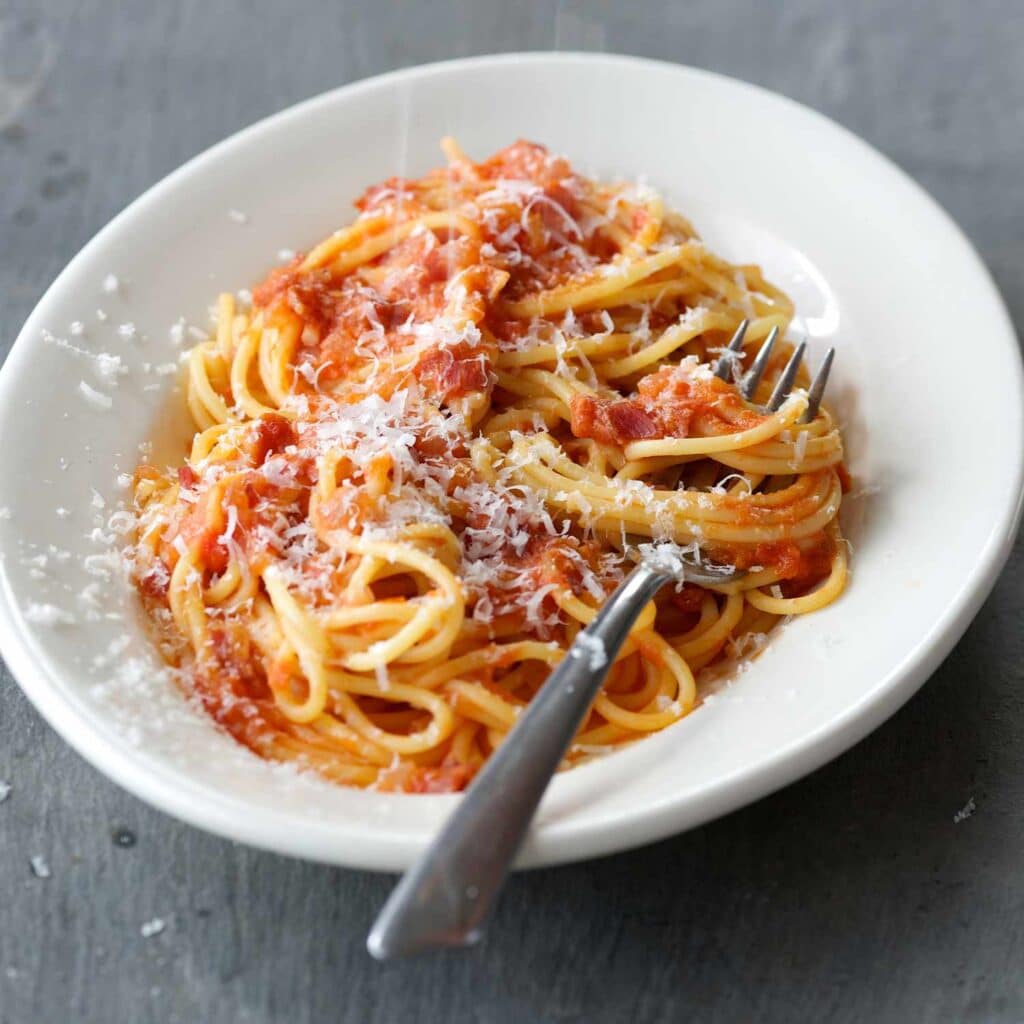
Creamy Spaghetti Bolognese
Add heavy cream or sour cream to the sauce to make it creamier and richer.
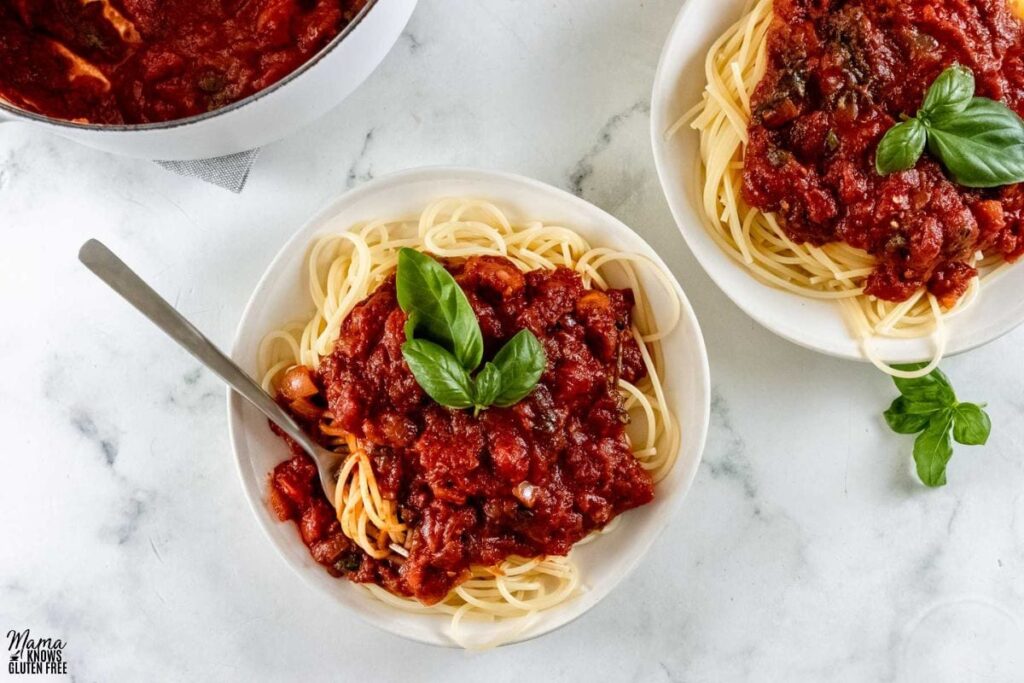
Gluten-free Spaghetti Bolognese
Use gluten-free pasta or zucchini noodles instead of regular spaghetti to make the dish gluten-free.
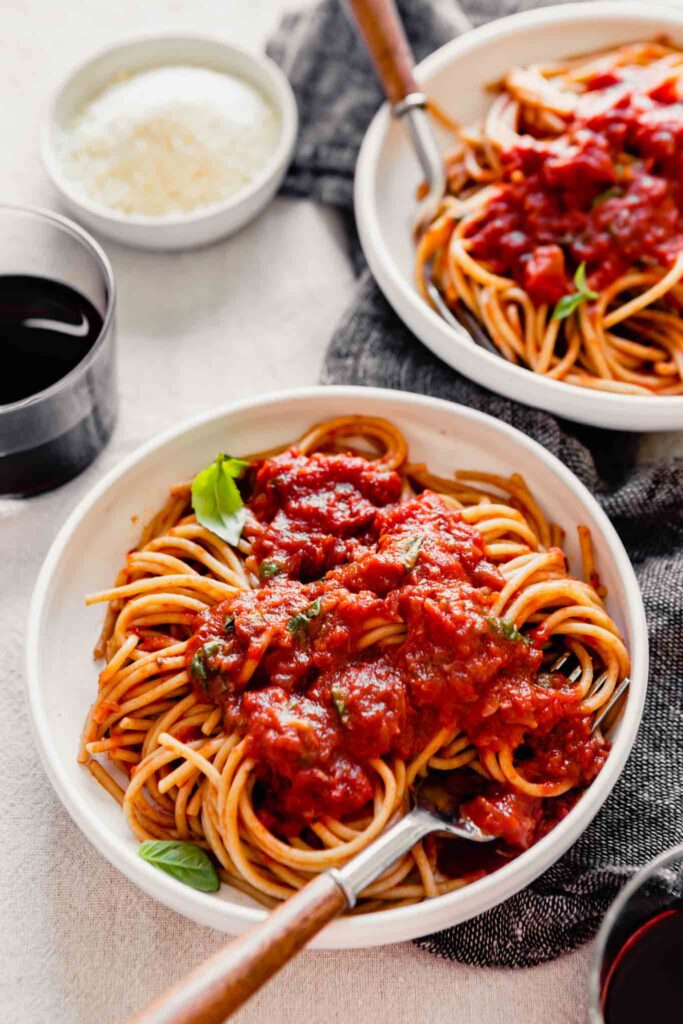
Spaghetti Bolognese with Wine
Add a splash of red wine to the sauce to enhance the flavour.
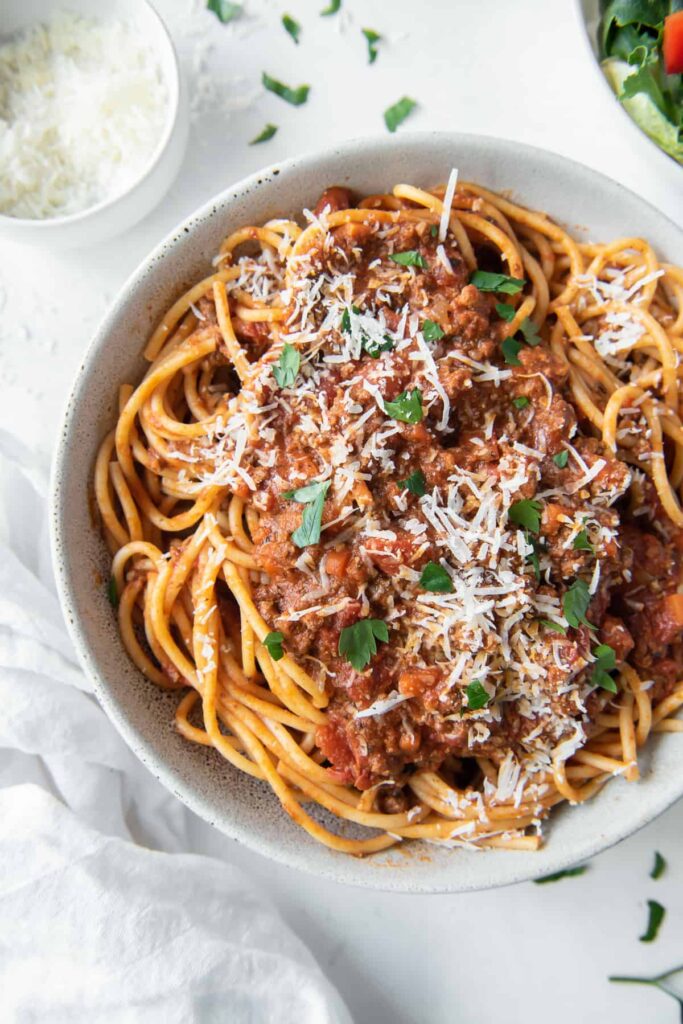
Spaghetti Bolognese with Cheese
Add grated Parmesan cheese or other types of cheese like mozzarella or cheddar to the sauce or sprinkle on top before serving.
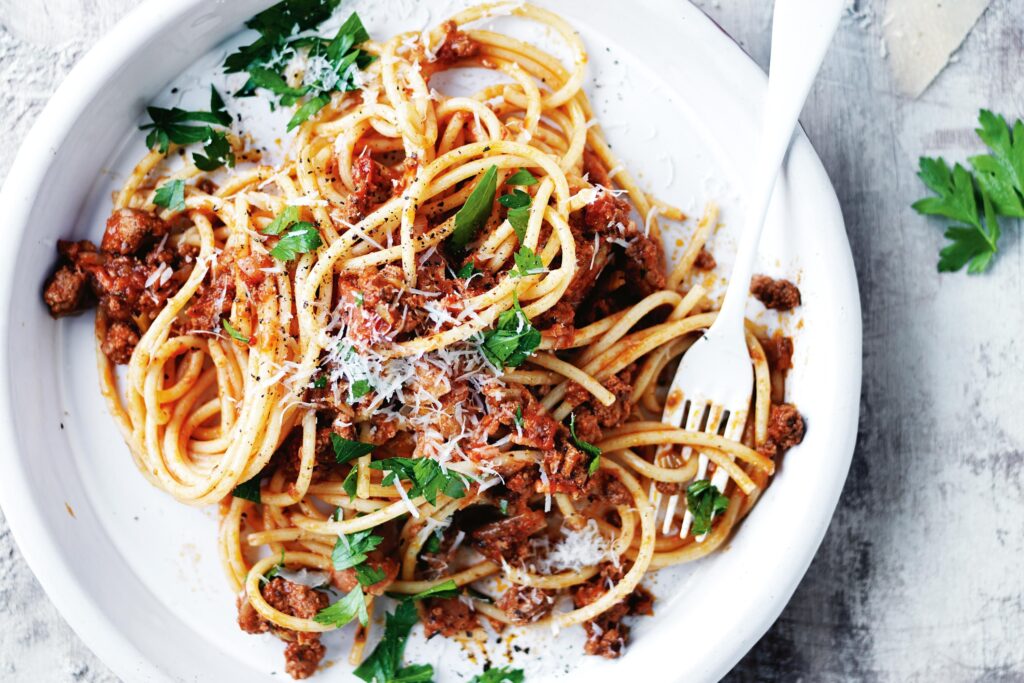
Spaghetti Bolognese with Bacon
Add crispy bacon bits to the sauce for a smoky flavor.
Related: 15+ Best Round Steak Recipe You Should Try
Health Benefits of Spaghetti Bolognese Ingredients
1. Oregano
Oregano is a culinary herb known for its peppery and pungent taste. In addition to bringing a unique flavour and aroma to pasta recipes, oregano also offers several potential health benefits, thanks to the presence of natural compounds like carvacrol and thymol. Oregano extract could act as an antioxidant and slow the growth of certain types of bacteria.
2. Rosemary Oil
This fragrant herb has a slightly sweet taste and distinct aroma that works well in a wide range of recipes, including pasta.
Besides adding an extra dose of flavor to dishes, rosemary may also possess potent health-promoting properties. It’s also rich in several antioxidants and beneficial compounds, including rosmarinic acid, caffeic acid, eugenol, and carnosol.
3. Red pepper flakes
Red pepper flakes are made from dried and crushed red chilli peppers. People often use them to dial up the heat and nutritional value of many different pasta dishes.
They contain capsaicin, the compound that gives chilis their spiciness. They are known to alleviate pain and speed up metabolism to help you maintain a moderate weight.
4. Garlic
Adding garlic powder to your pasta can be a convenient and easy way to take advantage of garlic’s many health benefits. Garlic helps lower cholesterol, decrease inflammation, and support healthy blood pressure levels.
While Spaghetti Bolognese is often considered a comfort food, it does provide some health benefits when consumed in moderation and as part of a balanced diet.
Here are some potential health benefits of Spaghetti Bolognese:
5. Protein
Spaghetti Bolognese contains protein from ground beef or turkey, which is essential for building and repairing tissues in the body.
6. Vitamins and Minerals
The dish also contains vitamins and minerals from the tomato sauce, onion, garlic, and other vegetables, which can help support overall health and well-being.
7. Antioxidants
Tomatoes, which are a key ingredient in Spaghetti Bolognese, are a good source of antioxidants, which can help protect against cellular damage and lower the risk of chronic diseases.
8. Fiber
Spaghetti Bolognese made with whole-grain pasta can be a good source of fibre, which is important for digestion and can help lower the risk of heart disease, diabetes, and other health conditions.
9. Low-Carb Options
Many low-carb variations of Spaghetti Bolognese are available that use zucchini noodles or spaghetti squash instead of traditional pasta, which can be a good option for those watching their carbohydrate intake.
It’s worth noting that Spaghetti Bolognese can also be high in calories, fat, and sodium depending on the recipe and serving size, so it’s important to enjoy it in moderation and as part of a balanced diet.
CHECK THESE OUT: 30+ Healthy Dessert Recipes You Should Try
Spaghetti Bolognese Serving Suggestions
Here are some serving suggestions for spaghetti bolognese:
1. Garlic bread
Serve your spaghetti bolognese with some garlic bread on the side. The buttery, garlicky flavour pairs perfectly with the rich tomato sauce.
2. Parmesan cheese
Grate some fresh Parmesan cheese over the top of your spaghetti bolognese. The salty, nutty flavour adds depth and richness to the dish.
3. Salad
Serve a simple green salad on the side of your spaghetti bolognese for a fresh, crisp contrast to the warm pasta.
4. Wine
Pair your spaghetti bolognese with a nice red wine like Chianti or Sangiovese. The acidity and tannins in the wine will complement the acidity and richness of the tomato sauce.
5. Vegetables
Add some vegetables to your spaghetti bolognese, such as sautéed mushrooms, bell peppers, or zucchini, for added nutrition and flavour.
6. Breadsticks
Dip breadsticks in the tomato sauce of your spaghetti bolognese for a delicious and satisfying bite.
7. Fresh herbs
Garnish your spaghetti bolognese with some fresh herbs, such as basil or parsley, for a pop of colour and flavour.
Related: 25+ Mouth-Watering Milkshake Recipe you need to try
Conclusion
Spaghetti bolognese is a classic dish for many reasons. Firstly, it is a comforting and satisfying meal that can be enjoyed by people of all ages. The combination of tender spaghetti noodles and rich meaty tomato sauce is a crowd-pleaser that has stood the test of time.
Secondly, spaghetti bolognese is easy to make and can be customized to suit individual tastes. With a few simple ingredients, anyone can whip up a delicious batch of spaghetti bolognese in no time.
Thirdly, spaghetti bolognese is versatile and can be served in a variety of ways, from a casual family dinner to a fancy dinner party. It can be paired with garlic bread, Parmesan cheese, salad, and wine to create a well-rounded and satisfying meal.
Lastly, spaghetti bolognese has a rich history and cultural significance. It originated in Bologna, Italy, and has since become a beloved dish all over the world. Its popularity has led to countless variations and adaptations, making it a truly global cuisine.
Overall, spaghetti bolognese is a classic dish that is here to stay. Its delicious taste, easy preparation, versatility, and cultural significance make it a go-to meal for any occasion.
Related: How to Make Fufu (Foofoo) from Scratch
FAQs
What is spaghetti bolognese made of?
Spaghetti bolognese is just the name of spaghetti tossed in a sauce made from tomatoes, minced beef, garlic, wine, herbs, and spices. It is a classic Italian dish.
What is the difference between spaghetti and bolognese?
Bolognese is a kind of ragù (the Italian word for meat sauce), originally from Bologna, Italy. It’s very different from your usual American meat sauce, often a tomato-based sauce simmered with ground beef. Bolognese is much thicker, creamier (milk is one of the ingredients), and with just a touch of tomato.
Why is it called spaghetti bolognese?
Bolognese does not involve spaghetti at all. Instead, the name comes from an initial recipe in Bologna, involving Tagliatelle and a rich ragù.
What does spaghetti bolognese taste like?
As far as its taste, it will have a meaty heartiness from the browned meats, a sweet tang from the rich tomatoes, as well as a herbal kick from the various Italian spices used. If you’ve ever enjoyed a pasta dish with meat and tomato-based sauce, it was likely a variation of a bolognese recipe.
What is the correct way to eat spaghetti bolognese?
To eat Spaghetti Bolognese try to work just a few strands of spaghetti onto your fork, then rest the tines against the indentation of the plate or the curve of the bowl. Twirl the fork around and lift it up briefly to keep additional spaghetti from getting wrapped into the mix. Once separated and neatly twirled, eat the pasta.
